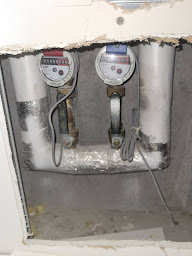Let's start with the most frequently asked question. "Why is the garbage system always down?" The short answer to that question is: it is not. We work tirelessly to try and keep the garbage system maintained and operational. However, I can see why it may seem that way. It does go down and it goes down far too often.
Now let's look at how our garbage system works. The garbage system is made up of three main parts.
- The Garbage Chute. This Chute goes from the 60th floor to Basement level 1. That is a very long shaft and a great distance for garbage, recycling, and organics to travel. Depending on the weight of the item(s), you may press the appropriate button inside the refuse room, but by the time those lighter items reach the bottom, the divider is no longer in the position that you selected. This is an important fact that we will come back to.
- The Tri-sorter. This is the dividing "blade" that moves into position based on what button you press in the refuse room on your floor. The three choices/positions are a) Garbage, b) Recycling, and c) Organics. In the garbage room on B1, there is a bin for each of those choices, placed beneath the appropriate openings.
- The Compactor. This is a motorized press of sorts. Its job is to compact refuse inside the attached garbage bin in order to take up less space and minimize the number of pick-ups we need as a Condominium Corporation.
We perform chute maintenance as well. Oiling hinges of the chute doors in the refuse rooms and making minor repairs if required. I am telling you all of this, for all of you to better understand the effort that goes into our waste removal.
So what is the problem? The vast majority of the time, the problem with the garbage system is what goes down the chute. There seems to be a misunderstanding or thought process, that as long as the item(s) is made to fit past the refuse room door and into the chute, the item(s) will make it to the bottom in the exact shape that left the hand that pushed it in. This of course is not the case. All of those big boxes that may have been folded over and over and placed down the chute, open up like an Accordion. Remember when I said that we would come back to number one? Bigger/inappropriate items create shelves that falling garbage rests on. Gravity and weight do aid the descent of the items but sometimes they don't make it down in time before the dividing blade tries to move into a different position. Those items now end up in between the blades, jamming the system and it responds by going into service mode.
What can you do to help? There are a few things that you can do to help us out.
- Communicate. There isn't a flashing light or indicator that informs building staff when the garbage system is off-line. We do check and check often, but outside of those times and especially after hours, We need people to let us know that the garbage system is not working. Please contact security when you discover that the garbage system is not operating properly.
- If the garbage system is not working, please do not place waste items in the refuse rooms. I know it isn't pleasant to hang on to items inside your unit, but leaving waste in the refuse room can cause other issues. If you absolutely must dispose of your waste immediately, please take it down to B1.
- Please follow the rules. I can almost feel the eye rolls on this one but the rules for garbage disposal are in place for a very good reason. Big items can not go down the chute. Inappropriate items can not go down the chute.
- Large cardboard. Ikea, Mattress boxes, television boxes, food delivery subscription boxes, diaper boxes.
Note: loading up a box with other items and then placing it down the chute, reinforces the box and makes it heavier. It is better to bag the items, place them in the chute and break the box down and place it inside the recycling room on B1. - Clothing, Bedding, and Linens. These items get stuck in the dividing blade very often. Please just bag and bring these items down to B1.
- Appliances of any size. Anything with a power cord in general. Power cords are the garbage systems' nemesis.
- Furniture of any size.
- Clothing hangers, storage boxes, and diaper pails (usually full of dirty diapers) should not go into the chute.
- Poles, broom handles, shower curtains, waste bins, rugs, and shelving units of any size.
- Metal, wood, paint cans, construction waste, or supplies. Flooring, tiling, drywall, and spray cans.
- Finally, but important because it happens on a daily basis. Sharps. please do not dispose of medical waste down the garbage chute. It is not likely to cause a garbage jam or cause the garbage system to go offline but it does create a hazard.
Following this will ultimately help keep the garbage system up and running and minimize the amount of time that the system is offline. We appreciate all of the help that we can get and thank you in advance!











